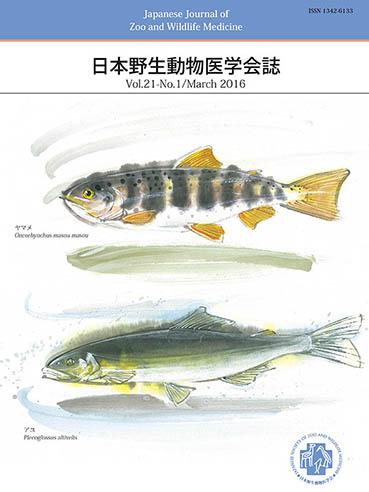
- Issue 4 Pages 111-
- Issue 3 Pages 47-
- Issue 2 Pages 29-
- Issue 1 Pages 1-
- |<
- <
- 1
- >
- >|
-
Kazutoshi TAKAMI2016 Volume 21 Issue 1 Pages 1-7
Published: March 31, 2016
Released on J-STAGE: May 04, 2018
JOURNAL FREE ACCESSIn Japan, totally, over 150 zoos and aquariums are keeping more than 6000 species, therefore they are expected to advance the wide-ranging researches to promote the conservation and utilization of valuable animals. Since zoos and aquariums maintain various species in captivity, it is comparatively easy to collect a variety of research samples. If these samples could be collected, organized and preserved systematically, effective utilization of samples will be promoted, and it will lead to the desirable research outcomes. Practical approaches are taken in many parts of the world, and also increasing slowly but steadily in zoo and aquariums in Japan. Osaka Municipal Tennoji Zoological Gardens cryopreserves the samples collected from more than 150 species to set up a tissue bank. Japanese Association of Zoos and Aquariums is collecting and preserving the germ cells systematically, and a framework to share the gametes is being put into place. In some cases, zoos and aquariums are collaborating with museums on the effective correction and preservation of samples by taking advantages of both worlds. In order to promote further efforts in this field, facilitation of the sample use, creation of a set of rules, and enhancement of the own research capacity of zoos and aquariums are required. Zoos and aquariums play a specific role in the research on wide range of animals. Their working on collection and preservation of research samples will gain more recognition as one of the key roles in the future.
View full abstractDownload PDF (587K) -
Hiroshi KOIE2016 Volume 21 Issue 1 Pages 9-10
Published: March 31, 2016
Released on J-STAGE: May 04, 2018
JOURNAL FREE ACCESSPhysiological and clinical researches on aquatic mammals have not been much conducted in most fields. Especially, the cardiovascular physiological studies including heart were hardly carried out. In small cetaceans, however, several areas of this research field, such as normal ECG waveform and histology of cardiac conduction system, have been studied by our laboratory. There are many aquariums in Japan now. It is expected that aquariums and educational and research institutions such as veterinary school establish the collaborations for investigations each other.
View full abstractDownload PDF (142K)
-
Tatsuo OSHIDA, A. Maksim ANTIPIN, G. Igori BOBYR, A. Irina NEVEDOMSKAY ...2016 Volume 21 Issue 1 Pages 11-16
Published: March 31, 2016
Released on J-STAGE: May 17, 2016
JOURNAL FREE ACCESSOn Kunashiri Island which is adjacent to the Shiretoko Peninsula of Hokkaido Island, we searched for three arboreal small mammal species common on Hokkaido Island: Siberian flying squirrel (Pteromys volans), small Japanese field mouse (Apodemus argenteus), and Eurasian red squirrel (Sciurus vulgaris). To find Siberian flying squirrel and small Japanese field mouse, we set 30 wooden nest boxes in a natural boreal mixed forest in the southern part of Kunashiri Island for two years (July 2013-August 2015). We did not find either species. In July 2012, we interviewed 30 inhabitants of Kunashiri Island about Eurasian red squirrel. No inhabitants saw Eurasian red squirrels. Therefore, it was suggested that there are no arboreal small mammals on Kunashiri Island, as reported previously. Loss of these three species could be due to severe forest reduction and environmental change during Pleistocene glaciation.View full abstractDownload PDF (186K) -
Yusaku WATANABE, Shinya FUKUMOTO, Ryô HARASAWA2016 Volume 21 Issue 1 Pages 17-27
Published: March 31, 2016
Released on J-STAGE: May 17, 2016
JOURNAL FREE ACCESSWe collected 36 blood samples from free-living sika deer (Cervus nippon) that were captured in a deer-overcrowded area in Fukui prefecture, and examined the prevalence of tick-borne microbes, including hemoplasmas, Piroplasma, and Anaplasma. Of the 36 samples of deer, 35 (97.2%) were infected with at least one hemotropic microbes. Thirteen (36.1%) deer samples were positive for ‘Candidatus Mycoplasma erythrocervae’ and 13 (36.1%) deer were positive for ‘Ca. M. haemocervae’. Similarly, 25 (69.4%) deer samples were positive for Theileria sp. Thrivae. One (2.8%) was positive for Theileria sp. Sola, five (13.9%) were positive for Anaplasma phagocytophilum, eight (22.2%) were positive for A. bovis, and 28 (77.8%) were positive for Anaplasma sp. This showed a high prevalence of tick-borne blood microorganisms in the deer population. Phylogenetic analysis of the 18S rRNA gene showed that the Theileria sp. Thrivae that was detected in this study formed a monophyletic cluster with other Theileria species that previously were detected in sika deer. This suggests that a novel Theileria species is prevalent in sika deer. Phylogenetic analyses of 16S rRNA gene showed that Anaplasma sp. in this study formed monophyletic groups with other Anaplasma species that were previously detected in Japanese cattle and wild ruminants. This suggests that a novel Anaplasma species is prevalent in sika deer.View full abstractDownload PDF (748K)
- |<
- <
- 1
- >
- >|